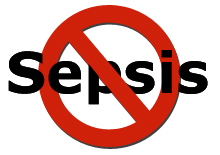| NYC Resources | 311 | Office of the Mayor |
|
|
Important notice on data breaches affecting some HHC patients |
Hospitals Fight Sepsis with Award-Winning Programs With early diagnosis and prompt treatment, Bellevue and Elmhurst Hospitals prevent complications and death from this hard to recognize infection
Though sepsis in hospital settings is rising around the world, HHC hospitals are bucking the trend with programs that are reducing the incidence of severe sepsis and death from septic shock. Elmhurst Hospital Center in Queens and Bellevue Hospital Center in Manhattan recently won awards at HHC’s Patient Safety Exposition 2013 for their special achievements battling the deadly systemic infection. Elmhurst won for reducing mortality from sepsis by adopting a standard treatment protocol to promptly deliver fluids and restore blood pressure. Bellevue Hospital won for stepping up efforts to quickly recognize and successfully manage patients with severe sepsis. Dr. Scott Weingart, director of critical care in the emergency department at Elmhurst, who co-chairs a regional STOP Sepsis hospital collaborative said, “Using evidence-based knowledge and solid teamwork between the ED and ICU, we successfully treated and released 80 percent of patients with sepsis and exceeded the collaborative’s average sepsis survival rates.” Sepsis produces inflammation that involves the entire body and usually occurs as a result of an overwhelming immune response to a bacterial infection. It most commonly occurs in the elderly and those with compromised immune systems. In severe cases, the patient’s blood pressure drops, prompting the body to go into shock, which can lead to failure of vital organs and death. But sepsis poses a challenge to healthcare providers because its symptoms - including fever, rapid heart rate and rapid breathing - also occur in other illnesses. Sepsis is the tenth leading cause of death in the United States, with an estimated 750,000 cases annually and a nearly 40% mortality rate. Severe sepsis costs the U.S. economy about $16.7 billion annually, according to the United Hospital Fund. In 2010, the Greater New York Hospital Association and United Hospital Fund announced a STOP Sepsis Collaborative with more than 50 participating area hospitals, including Elmhurst and Bellevue. Its goal is to reduce deaths from sepsis by developing and using a series of steps for rapid identification and treatment of sepsis and improving interdepartmental communication. Dr. Weingart and his colleagues at Elmhurst championed a best-practice model called Early Goal-Directed Therapy. It requires nurses and clinicians to intensively identify, monitor and treat septic patients with unstable blood pressure by promptly giving intravenous fluids and antibiotics. Dr. Ram Parekh, attending physician in emergency medicine at Elmhurst said, “The project does two things: it raises awareness of nurses and physicians, and it leads to earlier recognition of sepsis, which prompts earlier treatment and more rapid completion of the protocol.” In 2011 and 2012, Elmhurst cared for a total of 197 patients with severe sepsis, and its average response time of 3 hours and 21 minutes far surpassed the 6-hour target goal of the collaborative, as well as the average time of all collaborative-participating hospitals, which was 11 hours and 23 minutes.
At Bellevue Hospital Center, their Sepsis Team members were able to identify patients with sepsis much faster, leading to quicker treatment and recovery, says Laura Evans, MD. M.Sc., who is medical director of critical care. They developed a “Sepsis Alert” system and a “Sepsis Response Team” with representatives from many departments, who agreed on a set of rules for managing patients with severe sepsis and septic shock. Among other steps, the team conducts monthly drills and weekly reviews of the response to all sepsis cases. “The idea behind it is that reliable application of simple therapies such as fluid and antibiotics dramatically improves the outcome of patients with severe sepsis and septic shock,” Dr. Evans said. She said Bellevue sees in the range of 500 cases of severe sepsis and septic shock annually in adult patients, two-thirds of those in the emergency department and one-third in the inpatient units. Dr. Evans said, "Over the past year, the average time to fluids for patients presenting to the emergency department with severe sepsis or septic shock has decreased by more than 50%." All of the hospitals’ antisepsis initiatives rely heavily on nurses as the first line of defense. Patricia Ann Tennill, RN, the assistant director of nursing at Bellevue, added, “Early recognition helps the patients and helps the workload in the long run. We all work together to stabilize the patient and get them where they need to be.”
| |||||||||||||||||||||
HHC 2014 Stats
- Staffed Beds: 6,684
- Clinic Visits: 4,472,960
- ER Visits: 1,179,436
- Discharges: 205,791
- Births: 18,564
| Copyright 2015 The City of New York | Contact Us | Privacy Policy | Terms of Use |


